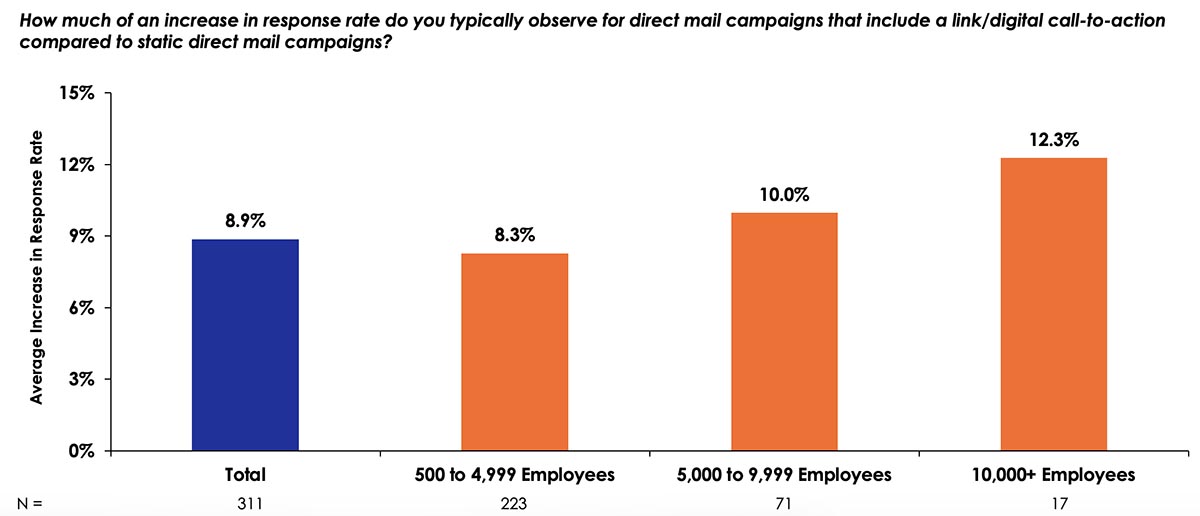- PSPs are investing in specialty printing products that support special paper/substrates, color embellishments, personalization, special finishing, or quick response (QR) codes.
- On average, direct mail campaigns that included digital links yielded a response rate increase of nearly 9% in relation to static campaigns.
- PSPs can sell the value of print with strategies that can incorporate customization/ personalization, specialty printing, or e-connectivity options.
By German Sacristan and Priya Gohil
Introduction
Today’s print service providers (PSPs) have access to all the technologies they need to produce effective printed communications. Unfortunately, technology is not enough to guarantee that customers will experience a positive return on their marketing investments in this highly competitive and saturated market.
Planning a marketing campaign is much more complicated than it used to be. Budgets are a key consideration, and some marketers might be tempted to abandon print in favor of electronic communications. This is hardly surprising given the lower cost, immediacy, and targeted reach of electronic campaigns. At the same time, however, the sheer volume of electronic messages peppering today’s consumers can make it difficult to capture an audience’s attention—which is the first objective of any communicator.
When used correctly, printed communications can still wield an irresistible power. For one thing, they are often delivered to mailboxes, and direct mail is one of the less competitive channels from which marketers can choose to communicate. Direct mail’s allure also spans generations—the United States Postal Service (USPS) asserts that younger adults do read direct mail. In fact, the vast majority of Millennials (88%) take the time to look through their direct mail to ensure that they’re not discarding important information.
Print Remains an Important Part of Any Marketing Strategy
Marketers continue to view print as an important part of their overall marketing strategies. According to Keypoint Intelligence’s Print Buyer Marketing Survey:
- Marketing budgets are expected to rise by an average of 9% through 2024.
- Print spending is expected to remain flat, but the demand for certain applications (e.g., direct mail, catalogs, training materials) is growing.
- Short-run, more frequent print jobs will dominate.
- PSPs are investing in specialty printing products that support special paper/substrates, color embellishments, personalization, special finishing, or quick response (QR) codes.
Another key advantage of print is that it works well with digital enhancements like augmented reality (AR), QR codes, or near-field communication (NFC) tags. Printed communications can lead consumers back to digital for a seamless, personalized experience across all channels. Keypoint Intelligence’s 2023 direct marketing communications research confirms that the vast majority of businesses (97%) are incorporating digital links in their printed direct mail at least occasionally. On average, direct mail campaigns that included digital links yielded a response rate increase of nearly 9% in relation to static campaigns. It is interesting to note that larger firms reported slightly higher average response rates.
Figure 1: Average Increase in Response Rate from Linking Digital with Print (By Number of Employees)

Base: Business Respondents that always, usually, or sometimes include a digital link with printed direct mail
Source: Direct Marketing Communications Business Survey; Keypoint Intelligence 2023
Today’s consumers want to receive personalized communications. As a result, it comes as little surprise that the most popular types of digital links include personalized QR codes and personalized URLs (pURLs).
Figure 2: Most Popular Method of Incorporating Digital with Print

N = 311 Business Respondents that always, usually, or sometimes include a digital link with printed direct mail
Source: Direct Marketing Communications Business Survey; Keypoint Intelligence 2023
For consumers, personalized communications are relevant, helpful, and informative. While marketers of course want to tell consumers what they want to hear, it’s often difficult to determine what will make the communication seem personalized to the recipient. Marketers will often rely on service providers and their technologies to change the message from one consumer to the next, but this unfortunately does not guarantee relevance. Therefore, marketers struggle to get a return on their investment.
Herein lies an opportunity for PSPs to step in and sell the value of print to their clients, with strategies that link to their customers’ main communication objectives of capturing attention, being relevant, and making it easier for people to do what they want them to do. PSPs can use printing technologies and techniques such as variable data, specialty printing, or e-connectivity options.
The Bottom Line
Although today’s marketers might understandably prioritize digital channels, print still holds power. There are pockets of growth in certain commercial print applications like direct mail and catalogs. Other factors, such as shrinking print lengths, a greater number of print jobs being printed more frequently, and customization, are fertile ground for digital printing. Similarly, specialty prints that include personalization, special substrates/finishing, and e-connectivity can create relevant and effective communications that stand out for customers and prospects. Once PSPs develop an understanding of their customers’ marketing goals and objectives, they can help develop campaign strategies that leverage the strengths of print to improve ROI.
German Sacristan is the Group Director of Keypoint Intelligence's Production Printing Group. In this role, he supports clients with strategic go-to-market advice related to production printing in graphic arts and similar industry segments. His responsibilities include conducting market research, custom consulting, developing forecasts and analyses, and creating editorial content on technology.
With over two decades of publishing experience, Priya Gohil has been providing A3, production, and wide format analysis since joining Keypoint Intelligence in 2013. While sharply focused on custom test reporting as well as high-value subscription content, she also authors blogs and a variety of other Keypoint Intelligence articles.










Discussion
Join the discussion Sign In or Become a Member, doing so is simple and free